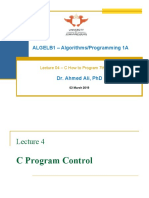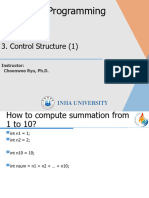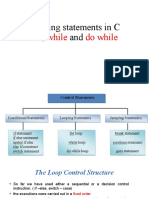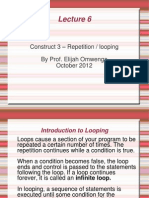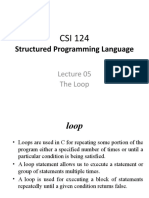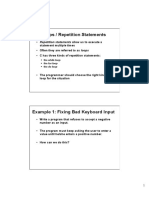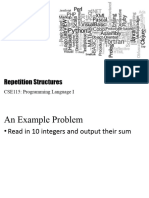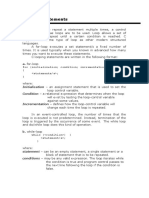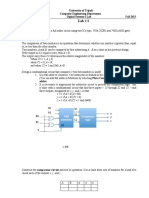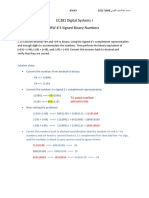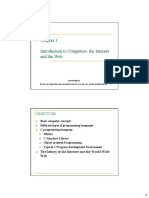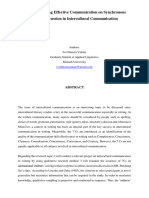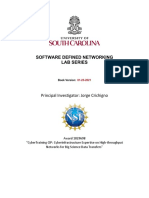Chapter 4
C Program Control
Acknowledgment
The notes are adapted from those provided by Deitel & Associates, Inc. and Pearson Education Inc.
OBJECTIVES
In this lecture, you will learn:
The while, for and do...while repetition statements
to execute statements in a program repeatedly;
The break and continue program control statements to
alter the flow of program control;
The switch selection statement;
The logical operators to form complex conditional
expressions in control statements;
To avoid confusing the equality and assignment operators
Structured-Programming Summary
Review
54
�Repetition Essentials
Loop
Group of instructions computer executes repeatedly while
some condition remains true
Counter-controlled repetition
Definite repetition: know how many times loop will
execute
Control variable used to count repetitions
Sentinel-controlled repetition
Indefinite repetition
Used when number of repetitions not known
Sentinel value indicates "end of data"
Counter-Controlled Repetition
Counter-controlled repetition requires
The name of a control variable (or loop counter)
The initial value of the control variable
An increment (or decrement) by which the control
variable is modified each time through the loop
A condition that tests for the final value of the control
variable (i.e., whether looping should continue)
55
� Counter-Controlled Repetition
Example:
int counter = 1; // initialization
while ( counter <= 10 ) { // repetition
condition
di i
printf( "%d\n", counter );
++counter; // increment
}
The statement
int counter = 1;
Names counter
Defines it to be an integer
Reserves space for it in memory
Sets it to an initial value of 1
1 /* Fig. 4.1: fig04_01.c
2 Counter-controlled repetition */
3 #include <stdio.h>
4
5 /* function main begins program execution */
6 int main( void )
7 {
8 int counter = 1; /* initialization */ Definition and assignment are performed
9 simultaneously
10 while
hil ( counter <= 10 ) { /*
/ repetition
i i condition
di i */
/
11 printf ( "%d\n", counter ); /* display counter */
12 ++counter; /* increment */
13 } /* end while */
14
15 return 0; /* indicate program ended successfully */
16
17 } /* end function main */
1
2
3
4
5
6
7
8
9
10
56
�Counter-Controlled Repetition
Condensed code
C Programmers would make the program more concise
Initialize
t a e cou te to 0
counter
while ( ++counter <= 10 )
printf( “%d\n, counter );
Important Notice!
Controlling counting loops with floating-point variables may
result in imprecise counter values and inaccurate tests for
termination
Reason: floating-point values may be approximate.
57
�1 /* Fig. 4.2: fig04_02.c
2 Counter-controlled repetition with the for statement */
3 #include <stdio.h>
4
5 /* function main begins program execution */
6 int main( void )
7 {
8 int counter; /
/* define counter */
/
9
10 /* initialization, repetition condition, and increment
11 are all included in the for statement header. */
12 for ( counter = 1; counter <= 10; counter++ ) { for loop begins by setting counter to 1
13 printf( "%d\n", counter );
and repeats while counter <= 10.
14 } /* end for */
15 Each time the end of the loop is reached,
16 return 0; /* indicate program ended successfully */ counter is incremented by 1.
17
18 } /* end function main */
The for Repetition Statement
58
�The for Repetition Statement
Format when using for loops
for ( initialization; loopContinuationTest; increment )
statement
Example:
for( int counter = 1; counter <= 10; counter++ )
printf( "%d\n", counter );
Prints the integers from one to ten No
semicolon
(;) after last
expression
The for Statement
For loops can usually be rewritten as while loops:
initialization;
while ( loopContinuationTest ) {
statement;
increment;
}
Initialization and increment
Can be comma-separated lists
Example:
for (int i = 0, j = 0; j + i <= 10; j++,
i++)
printf( "%d\n", j + i );
59
�The for Statement : Notes and Observations
Arithmetic expressions
Initialization, loop-continuation, and increment can contain
arithmetic expressions. If x equals 2 and y equals 10
f
for ( j = x; j <= 4 * x * y; j += y / x )
is equivalent to
for ( j = 2; j <= 80; j += 5 )
Notes about the for statement:
"Increment" may be negative (decrement)
If the loop continuation condition is initially false
The body of the for statement is not performed
Control proceeds with the next statement after the for
statement
Control variable
Often printed or used inside for body, but not necessary
Notice!
Although the value of the control variable can be changed in
the body of a for loop, this can lead to subtle errors. It is best
not to change it.
60
� Flowcharting a typical for repetition statement
1 /* Fig. 4.6: fig04_06.c
2 Calculating compound interest */
3 #include <stdio.h>
4 #include <math.h> additional header
5
6 /* function main begins program execution */
7 int main( void )
8 {
9 double amount; /* amount on deposit */
10 double principal = 1000.0; /* starting principal */
11 d bl rate
double t = .05;
05 /* annual
l interest
i t t rate
t */
12 int year; /* year counter */
13
14 /* output table column head */
15 printf( "%4s%21s\n", "Year", "Amount on deposit" );
16
17 /* calculate amount on deposit for each of ten years */
18 for ( year = 1; year <= 10; year++ ) {
19
20 /* calculate new amount for specified year */
21 amount = principal * pow( 1.0 + rate, year );
pow function calculates the value of the
22 first argument raised to the power of
23 /* output one table row */ the second argument; It takes two
24 printf( "%4d%21.2f\n", year, amount ); arguments of type double and returns a
25 } /* end for */ double value.
26
27 return 0; /* indicate program ended successfully */
28
29 } /* end function main */
61
�Year Amount on deposit
1 1050.00
2 1102.50
3 1157.63
4 1215.51
5 1276.28
6 1340.10
7 1407 10
1407.10
8 1477.46
9 1551.33
10 1628.89
The do…while Repetition Statement
The do…while repetition statement
Similar to the while structure
Co
Condition
d t o for
o repetition
epet t o tested aafter
te tthee body oof tthee loop
oop iss
performed
All actions are performed at least once
Format:
do {
statement;
} while ( condition );
62
�The do…while Repetition Statement
Example (letting counter = 1):
do {
printf( "%d ", counter );
} while
hile (++counter
( co nter <= 10);
10)
Prints the integers from 1 to 10
Flowchart of the do…while repetition statement
63
�1 /* Fig. 4.9: fig04_09.c
2 Using the do/while repetition statement */
3 #include <stdio.h>
4
5 /* function main begins program execution */
6 int main( void )
7 {
8 int counter = 1; /* initialize counter */
9
10 do {
11 printf( "%d ", counter ); /* display counter */
12 } while ( ++counter <= 10 ); /* end do...while */ increments counter then checks if it is
13
less than or equal to 10
14 return 0; /* indicate program ended successfully */
15
16 } /* end function main */
1 2 3 4 5 6 7 8 9 10
The break and continue Statements
break
Causes immediate exit from a while, for, do…while or
switch statement
Program execution continues with the first statement after
the structure
Common uses of the break statement
Escape early from a loop
Skip the remainder of a switch statement
64
�1 /* Fig. 4.11: fig04_11.c
2 Using the break statement in a for statement */
3 #include <stdio.h>
4
5 /* function main begins program execution */
6 int main( void )
7 {
8 int x; /* counter */
9
10 /* loop 10 times */
/ /
11 for ( x = 1; x <= 10; x++ ) {
12
13 /* if x is 5, terminate loop */
14 if ( x == 5 ) {
15 break; /* break loop only if x is 5 */ break immediately ends for loop
16 } /* end if */
17
18 printf( "%d ", x ); /* display value of x */
19 } /* end for */
20
21 printf(
i f( "\nBroke
"\ k out of
f loop
l at x == %d\n",
%d\ " x );
)
22
23 return 0; /* indicate program ended successfully */
24
25 } /* end function main */
1 2 3 4
Broke out of loop at x == 5
The break and continue Statements
continue
Skips the remaining statements in the body of a while, for
or do…while statement
Proceeds with the next iteration of the loop
while and do…while
Loop-continuation test is evaluated immediately after the
continue statement is executed
for
Increment
c e e t expression
e p ess o iss executed,
e ecuted, then
t e the
t e loop-continuation
oop co t uat o
test is evaluated
65
�1 /* Fig. 4.12: fig04_12.c
2 Using the continue statement in a for statement */
3 #include <stdio.h>
4
5 /* function main begins program execution */
6 int main( void )
7 {
8 int x; /* counter */
9
10 /* loop 10 times */
11 for ( x = 1; x <= 10; x++ ) {
12
13 /* if x is 5, continue with next iteration of loop */
14 if ( x == 5 ) {
15 continue; /* skip remaining code in loop body */ continue skips to end of for
16 } /* end if */
loop and performs next iteration
17
18 printf( "%d ", x ); /* display value of x */
19 } /* end for */
20
21 printf( "\nUsed continue to skip printing the value 5\n" );
22
23 return 0; /* indicate program ended successfully */
24
25 } /* end function main */
1 2 3 4 6 7 8 9 10
Used continue to skip printing the value 5
The switch Multiple-Selection Statement
switch
Useful when a variable or expression is tested for all the
values it can assume and different actions are taken
Format
Series of case labels and an optional default case
switch ( value ){
case '1':
actions
case '2':
actions
ti
default:
actions
}
break; exits from statement
66
� Flowchart of the switch statement
1 /* Fig. 4.7: fig04_07.c
2 Counting letter grades */
3 #include <stdio.h>
4
5 /* function main begins program execution */
6 int main( void )
7 {
8 int grade; /* one grade */
9 int aCount = 0; /* number of As */
10 int bCount = 0; /* number of Bs */
11 int cCount = 0; /* number of Cs */
12 int dCount = 0; /* number of Ds */
13 int fCount = 0; /* number of Fs */
14
15 printf( "Enter the letter grades.\n" );
16 printf( "Enter the EOF character to end input.\n" );
17
18 /* loop until user types end-of-file key sequence */
19 while ( ( grade = getchar() ) != EOF ) {
20
EOF stands for “end of file;” this character varies
21 /* determine which grade was input */ from system to system
22 switch
i h ( grade
d ) { /* switch
i h nested
d in
i while
hil */
23 switch statement checks each of its nested
24 case 'A': /* grade was uppercase A */ cases for a match
25 case 'a': /* or lowercase a */
26 ++aCount; /* increment aCount */
27 break; /* necessary to exit switch */
28
break statement makes program skip to end of switch
67
�29 case 'B': /* grade was uppercase B */
30 case 'b': /* or lowercase b */
31 ++bCount; /* increment bCount */
32 break; /* exit switch */
33
34 case 'C': /* grade was uppercase C */
35 case 'c': /* or lowercase c */
36 ++cCount; /* increment cCount */
37 break; /* exit switch */
38
39 case 'D': /* grade was uppercase D */
40 case 'd': /* or lowercase d */
41 ++dCount; /* increment dCount */
42 break; /* exit switch */
43
44 case 'F': /* grade was uppercase F */
45 case 'f': /* or lowercase f */
46 ++fCount; /* increment fCount */
47 break; /* exit switch */
48
49 case '\n':
\n : /* ignore newlines,
newlines */
50 case '\t': /* tabs, */
51 case ' ': /* and spaces in input */
52 break; /* exit switch */
53
54 default: /* catch all other characters */
55 printf( "Incorrect letter grade entered." );
56 printf( " Enter a new grade.\n" );
57 break; /* optional; will exit switch anyway */ default case occurs if none of the
58 } /* end switch */ cases are matched
59
60 } /* end while */
61
62 /* output summary of results */
63 printf( "\nTotals for each letter grade are
are:\n"
\n" );
)
64 printf( "A: %d\n", aCount ); /* display number of A grades */
65 printf( "B: %d\n", bCount ); /* display number of B grades */
66 printf( "C: %d\n", cCount ); /* display number of C grades */
67 printf( "D: %d\n", dCount ); /* display number of D grades */
68 printf( "F: %d\n", fCount ); /* display number of F grades */
69
70 return 0; /* indicate program ended successfully */
71
72 } /* end function main */
68
�Enter the letter grades.
Enter the EOF character to end input.
a
b
c
C
A
d
f
C
E
Incorrect letter grade entered. Enter a new grade.
D
A
b
^Z
Totals for each letter grade are:
A: 3
B: 2
C: 3
D: 2
F: 1
Logical Operators
&& ( logical AND )
Returns true if both conditions are true
|| ( logical
og ca OR
O )
Returns true if either of its conditions are true
! ( logical NOT, logical negation )
Reverses the truth/falsity of its condition
Unary operator, has one operand
Useful as conditions in loops
Expression Result
true && false false
true || false true
!false true
69
�Logical Operators
expression1 expression2 expression1 && expression2
0 0 0
0 nonzero 0
nonzero 0 0
nonzero nonzero 1
Fig. 4.13 | Truth table for the && (logical AND) operator.
expression1 expression2 expression1 || expression2
0 0 0
0 nonzero 1
nonzero 0 1
nonzero nonzero 1
Fig. 4.14 | Truth table for the logical OR (||) operator.
expression !expression
0 1
nonzero 0
Fig. 4.15 | Truth table for operator ! (logical negation).
Operator Precedence and Associativity
Operators Associativity Type
++ (postfix) -- (postfix) right to left postfix
+ - ! ++ (prefix) -- (prefix) (type) right to left unary
* / % left to right multiplicative
+ - left to right additive
< <= > >= left to right relational
== != left to right equality
&& left to right logical AND
|| left to right logical OR
?: right to left conditional
= += -= *= /= %= right to left assignment
, left to right comma
70
�Confusing Equality (==) and Assignment (=) Operators
Dangerous error
Does not ordinarily cause syntax errors
Anyy eexpression
p ess o tthat
at pproduces
oduces a va
value
ue can
ca be used in control
co t o
structures
Nonzero values are true, zero values are false
Example using ==:
if ( payCode == 4 )
printf( "You get a bonus!\n" );
Checks payCode, if it is 4 then a bonus is awarded
Confusing Equality (==) and Assignment (=) Operators
Example, replacing == with =:
if ( payCode = 4 )
printf( "You get a bonus!\n" );
This
hi sets payCode d to 4
4 is nonzero, so expression is true, and bonus awarded no
matter what the payCode was
Logic error, not a syntax error
71
�Confusing Equality (==) and Assignment (=) Operators
lvalues
Expressions that can appear on the left side of an equation
Their
e values
va ues ca
can be changed,
c a ged, such
suc as variable
va ab e names
a es
x = 4;
rvalues
Expressions that can only appear on the right side of an
equation
Constants, such as numbers
Cannot write
C i 4 = x;
Must write x = 4;
lvalues can be used as rvalues, but not vice versa
y = x;
Structured-Programming Summary
72
�Structured-Programming Summary
Structured programming
Easier than unstructured programs to understand, test,
debug and, modify programs
Rules for structured programming
Rules developed by programming community
Only single-entry/single-exit control structures are used
Rules:
1. Begin with the “simplest flowchart”
2. Stacking rule: Any rectangle (action) can be replaced by two
rectangles
l (actions)
( i ) in i sequence
3. Nesting rule: Any rectangle (action) can be replaced by any
control structure (sequence, if, if…else, switch, while,
do…while or for)
4. Rules 2 and 3 can be applied in any order and multiple times
Structured-Programming Summary
Rule 2 - Any rectangle can be
Rule 1 - Begin with the
replaced by two rectangles in
simplest flowchart
sequence
73
�Structured-Programming Summary
Rule 3 - Replace any rectangle with a control structure
Stacked, nested and overlapped building blocks
74
�An unstructured flowchart
Structured-Programming Summary
All programs can be broken down into 3 controls
Sequence – handled automatically by compiler
Se
Selection
ect o – if, if…e se o
else or s
switch
tc
Repetition – while, do…while or for
Can only be combined in two ways
Nesting (rule 3)
Stacking (rule 2)
Any selection can be rewritten as an if statement, and any
repetition can be rewritten as a while statement
75
�Review
Counter-controlled and sentinel-controlled repetitions.
The for repetition statement handles all details of counter-
controlled repetition.
In most cases, for repetition statement can be represented
with an equivalent while repetition statement.
Initialization, loop-continuation condition and increment (or
decrement).
Data type double is a floating-point type much like float.
The conversion specifier %21.2f
%21 2f denotes that a floating-point
floating point
value will be displayed right 21 characters with two digits to
the right of the decimal point.
break and continue statements.
Review
switch multiple selection statement.
do…while repetition statement.
Logical
og ca operators
ope ato s && || !
Equality operator == and assignment operator =
76
